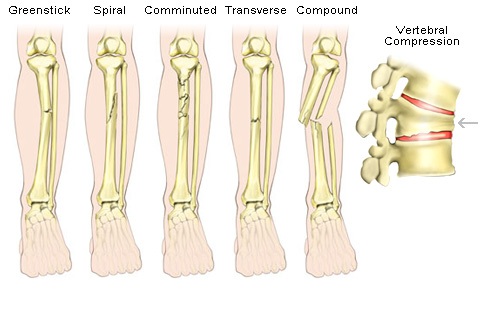A bone fracture is a medical condition in which there is a disruption in the continuity of the bone. Fractures are common especially in older adults. Fractures can be classified as diaphyseal (a fracture in the mid-portion of the bone), metaphyseal (a fracture within close proximity to the flare of the bone at the articular joint surface), and articular (a fracture within the joint surface at the end of the bone).
Closed fractures are fractures that are contained within the bone or joint. Open fractures are fractures that protrude through the soft-tissue and skin. The most common fracture to the upper extremity is a distal radius fracture or Colles fracture. The most common fracture to the lower extremity is the hip fracture.
Types of Fractures
- Greenstick are incomplete fracture. The broken bone is not completely separated.
- Spiral break are found around the bone; common in a twisting injury.
- Comminuted are bone fragments broken into several pieces.
- Transverse are straight line breaks across the bone.
- Compound break protrudes through the skin. Also called an open fracture.
- Compression is when the bone is crushed, causing the broken bone to be wider.
The most common symptoms of a fracture are:
- Swelling around the injured area
- Loss of function in the injured area
- Bruising around the injured area
- Deformity of a limb
OCCUPATIONAL THERAPY PERSPECTIVE
Occupational therapy goal following fracture surgery include:
- Reduction of pain and edema in the affected joint after surgery
- Maintenance of early active and passive range of motion (ROM) of the joint after surgery
- Restoration of functional activities of daily living (ADL) skills independence
- The return to pre-morbid occupational life roles
References
WebMD, article source: Bone Fracture, retreived from: http://www.webmd.com/a-to-z-guides/understanding-fractures-basic-information
Atchison, Ben J. & Dirette, Dianne K., 2007. Conditions in Occupational Therapy: Effect of Occupational Performance.
Kennealey, Moya., Morgan, Marlene J., Weiss, Donna., 2004. A Practitioner’s Guide to Clinical Occupational Therapy.
